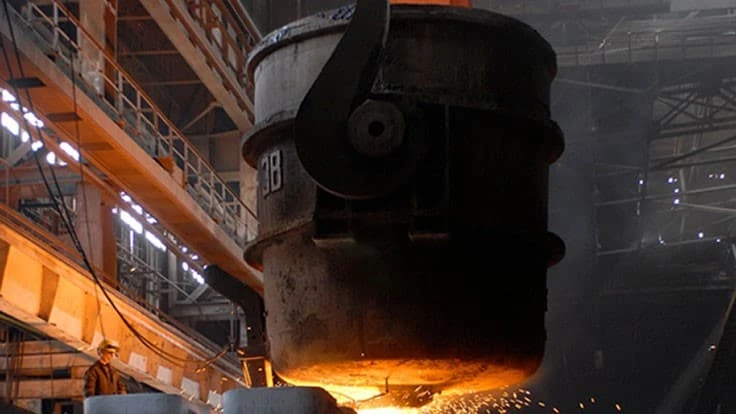
Photo courtesy of ArcelorMittal.
Several statistical measures point to global steel production levels entering 2021 with positive momentum as national economies rebound from declines in activity caused by COVID-19. Correlating upward price pressure on ferrous scrap has been plain to see.
As new 2021 calendars were placed on walls and desks, vaccination programs got underway in nations around the world. Securities and commodities buyers and speculators largely took this as a positive signal, placing upward price pressure on nearly every kind of metal.
In the steel sector, the combination of a return of economic activity—even in places where COVID-19 was still part of the fabric of life—and government infrastructure spending have caused mill output to reach pre-COVID-19 levels in many parts of the world.
Figures from the Brussels-based World Steel Association (Worldsteel) for November 2020 steel production portray a world where the output of most nations had reached or surpassed prepandemic levels.
Among the nations that raced past their November 2019 steel output levels were China, Turkey, India and the combined European Union market region.
Another example of the steelmaking revival is in Latin America, where steel output in Brazil and Mexico (the region’s largest producers) have returned to prepandemic levels. Latin America also provides an example, along with China and India, of places where infrastructure spending has helped prompt the rebound.
For scrap recyclers, the impacts of a return to prepandemic steel output are clear to see. In the United States, November scrap price increases were followed by an $80 per ton average price rise. Recyclers in the U.S. pointed to slowly rising domestic demand and steady-to-surging export demand.
Adding more price pressure could be the return of Chinese steelmakers to the global ferrous scrap market. Five People’s Republic of China government agencies have issued a memo signing off on standards and procedures allowing a dozen grades of imported ferrous scrap to be relabeled from “waste” to “resource” and cleared at ports.
The returning acceptance of scrap imports ties into the growth of state-owned steelmakers adding electric arc furnace (EAF) steel capacity. As one example, Reuters reported Jan. 5 that a subsidiary of Baowu Steel—among China’s largest steelmakers—has started up a 2.8 million metric tons per year EAF mill in Anhui Province, China.
“Many feel it may be the top of the market because they are in disbelief, yet some fundamentals support even higher numbers,” veteran trader Nathan Fruchter of New York-based Idoru Trading told Recycling Today in mid-December 2020. “We are going into winter, where tonnage can sometimes tighten up and transport can be hampered by cold weather. This affects U.S. and EU ports, but Baltic and Black Sea supplies even more. Steel demand is also back with a vengeance, so at least those prices seem to be in sync with scrap.”
A steel sector industry veteran, quoted anonymously in an early January article posted to The Fabricator website, foresees a bubble destined to burst. “This is 2004 and 2008 combined,” says the observer. “Everyone is scrambling for steel, so they are doubling up on orders. Even OEMs (original equipment manufacturers) have customers that are placing multiple orders because they are hedging their bets on who can get them the end product faster. Once that end product ships to them, they will cancel their order with the other OEM, and then this will ripple back through the steel supply chain. Remember, scrap and iron ore were also extremely elevated during 2008. Look at what the analysts are projecting for 2021. It all looks very familiar.”
Fruchter is not convinced China’s presence will be sudden or will add to the first quarter 2021 price pressure. “China can’t really afford $500-plus -per-ton scrap,” he comments. Fruchter also says most overseas traders will “not be rushing” to embrace sales to China, and have reservations about exposing themselves to “wishy-washy quality specifications and the absurd penalties they impose.”
There is no predicting how long a price spike will last, but the confluence of factors has some industry analysts predicting $1,000 per ton flat-rolled steel prices on the horizon. Scrap recyclers know well that where steel prices head, ferrous scrap values will follow, or vice versa.
Get curated news on YOUR industry.
Enter your email to receive our newsletters.
Latest from Recycling Today
- Fenix Parts acquires Assured Auto Parts
- PTR appoints new VP of independent hauler sales
- Updated: Grede to close Alabama foundry
- Leadpoint VP of recycling retires
- Study looks at potential impact of chemical recycling on global plastic pollution
- Foreign Pollution Fee Act addresses unfair trade practices of nonmarket economies
- GFL opens new MRF in Edmonton, Alberta
- MTM Critical Metals secures supply agreement with Dynamic Lifecycle Innovations






